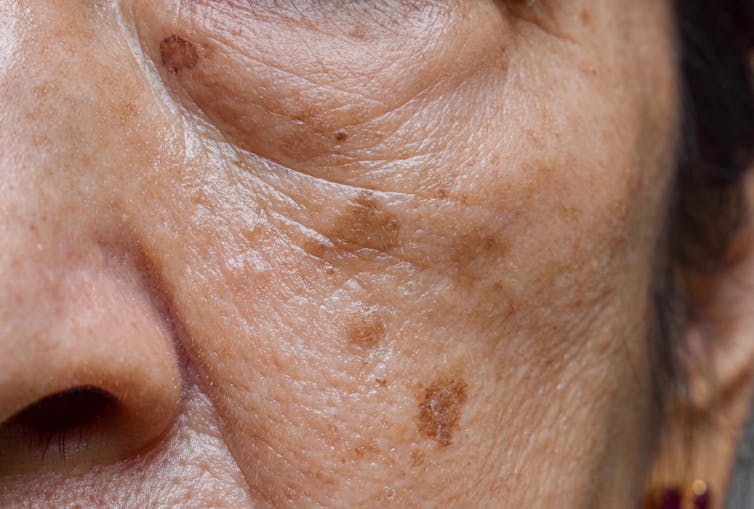What’s the difference between freckles, sunspots, and moles?


Freckles, Sunspots, and Moles: What’s the Difference?
You’ve got a new brown spot on your face, but is it a freckle or a sunspot? Or perhaps you’ve found a spot on your back that looks like a mole but is flatter than your other ones – is it a mole or a dark freckle?
Freckles
Freckles, known as ephelides, are small, flat, light brown spots that appear on people with fair skin, or red or light-coloured hair. These people are more likely to have the MC1R gene, which leads to freckles forming.
Freckles are caused by sun exposure and are more noticeable in summer. When sunlight hits the skin, cells called melanocytes produce melanin, the pigment that gives skin its colour. In people prone to freckles, the melanin doesn’t spread evenly. Instead, it clumps together, creating freckles.
Chermiti Mohamed/Unssplash
Freckles generally appear in childhood and may fade with age, especially if sun exposure reduces. As we age, we produce less melanin, or it can break down or disperse, resulting in lighter or fewer freckles.
Using sunscreen and wearing protective clothing can help prevent new freckles from developing, especially on the face and arms. While freckles are completely harmless, they are a sign that someone is genetically at higher risk of developing skin cancer.
Sunspots
Sunspots are also called age spots or actinic keratoses (or liver spots, but they have nothing to do with the liver). They are larger than freckles: sometimes the size of a small coin, and appear as flat brown spots.
Sunspots develop over time due to long-term sun exposure, which leads to excessive melanin production. They tend to appear on skin with greater sun exposure, such as the face, hands, shoulders, and arms.


Zay You/Shutterstock
Unlike freckles, which tend to get lighter with less sun exposure, sunspots will not fade with time, and may further darken with continued sun exposure. However, some people try to remove their sunspots for cosmetic reasons using either a laser, chemical peel, or prescription topical cream.
While sunspots are not dangerous, they do increase your risk of other skin cancers in that area. It’s also important to monitor them, as slow-growing melanomas may initially look like sunspots. If you see the spot changes in size, shape, or colour, see your doctor to rule out skin cancer.
Moles
Moles are often dark, raised or flat skin growths that can appear anywhere on your body.
Although moles can exist from birth, they typically grow during childhood, adolescence, and early adulthood (including during pregnancy, when hormones are changing), until around the age of around 40. Moles can increase in size, and new ones can also appear.
Most adults have between ten and 40 moles on their body. A person with a high mole count has 50 or more, while someone with a very high mole count has 100 or more.
Recent Posts
5 Ways to Treat Hormonal Acne and Clear Your Skin
Adult Acne: Causes, Treatments, and Lifestyle Changes 1. Lifestyle Changes Some lifestyle changes that may…
The Privilege of Pressure
Here is the rewritten article: After Overcoming Injuries and Other Obstacles, Bethany Flores is Ready…
Do any non-drug treatments help back pain?
Is back pain likely to be serious? There are different types of low back pain.…
2025 Sampson Showdown Pro Wellness Show
2025 Sampson Showdown Pro Roster The 2025 Sampson Showdown Pro is scheduled for Saturday, March…
7 Common Causes of Pulmonary Arterial Hypertension
Pulmonary Arterial Hypertension (PAH): Causes and Types 1. Idiopathic PAH About half of PAH cases…
Losing your job is bad for your health, but there are things you can do to minimize the harm
Pathway to Illness When people lose their jobs, they do have real problems. Typically, for…


